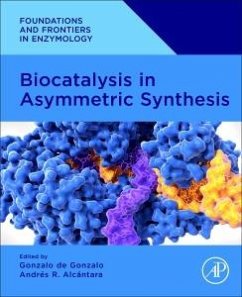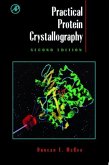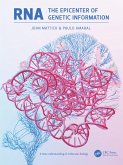Biocatalysis in Asymmetric Synthesis
Herausgeber: Gonzalo, Gonzalo de; Alcántara, Andrés R
Biocatalysis in Asymmetric Synthesis
Herausgeber: Gonzalo, Gonzalo de; Alcántara, Andrés R
- Broschiertes Buch
- Merkliste
- Auf die Merkliste
- Bewerten Bewerten
- Teilen
- Produkt teilen
- Produkterinnerung
- Produkterinnerung
Biocatalysis in Asymmetric Synthesis, a new volume in the Foundations and Frontiers of Enzymology series, offers an applied discussion on synthesizing biological catalysts using asymmetric synthesis for varying applications. Here, global experts in the field analyze a wide variety of biocatalysts and their physical states, process conditions for their asymmetric synthesis, solvents required during synthesis, and even downstream procedures for the recovery of final products. The book adopts an interdisciplinary approach, merging fundamental biology and its synthetic applications across…mehr
Andere Kunden interessierten sich auch für
![Transglutaminase Transglutaminase]() Transglutaminase183,99 €
Transglutaminase183,99 €![Carbon-Based Nanomaterials in Biosystems Carbon-Based Nanomaterials in Biosystems]() Carbon-Based Nanomaterials in Biosystems184,99 €
Carbon-Based Nanomaterials in Biosystems184,99 €![Practical Protein Crystallography Practical Protein Crystallography]() Duncan E. McReePractical Protein Crystallography214,99 €
Duncan E. McReePractical Protein Crystallography214,99 €![Protein Engineering and Design Protein Engineering and Design]() Paul R. Carey (ed.)Protein Engineering and Design167,99 €
Paul R. Carey (ed.)Protein Engineering and Design167,99 €![Ureases Ureases]() Ureases171,99 €
Ureases171,99 €![RNA, the Epicenter of Genetic Information RNA, the Epicenter of Genetic Information]() John MattickRNA, the Epicenter of Genetic Information90,99 €
John MattickRNA, the Epicenter of Genetic Information90,99 €![RNA, the Epicenter of Genetic Information RNA, the Epicenter of Genetic Information]() John MattickRNA, the Epicenter of Genetic Information155,99 €
John MattickRNA, the Epicenter of Genetic Information155,99 €-
-
-
Biocatalysis in Asymmetric Synthesis, a new volume in the Foundations and Frontiers of Enzymology series, offers an applied discussion on synthesizing biological catalysts using asymmetric synthesis for varying applications. Here, global experts in the field analyze a wide variety of biocatalysts and their physical states, process conditions for their asymmetric synthesis, solvents required during synthesis, and even downstream procedures for the recovery of final products. The book adopts an interdisciplinary approach, merging fundamental biology and its synthetic applications across industries with a wide range of practical examples, from directed evolution to biotransformation and production of novel enzymes and non-conventional catalysts. Throughout the book, the impact and application of biocatalysis in sustainable processing is considered in-depth. This book will also help non-experts in biocatalysis to apply this knowledge in their own research, providing a thorough overview of the ways asymmetric biocatalytic approaches may be adapted for different disciplines and downstream products.
Hinweis: Dieser Artikel kann nur an eine deutsche Lieferadresse ausgeliefert werden.
Hinweis: Dieser Artikel kann nur an eine deutsche Lieferadresse ausgeliefert werden.
Produktdetails
- Produktdetails
- Foundations and Frontiers in Enzymology
- Verlag: Elsevier Science Publishing Co Inc
- Seitenzahl: 520
- Erscheinungstermin: 8. Mai 2024
- Englisch
- Abmessung: 235mm x 191mm
- Gewicht: 1054g
- ISBN-13: 9780443190575
- ISBN-10: 0443190577
- Artikelnr.: 68168757
- Herstellerkennzeichnung
- Libri GmbH
- Europaallee 1
- 36244 Bad Hersfeld
- gpsr@libri.de
- Foundations and Frontiers in Enzymology
- Verlag: Elsevier Science Publishing Co Inc
- Seitenzahl: 520
- Erscheinungstermin: 8. Mai 2024
- Englisch
- Abmessung: 235mm x 191mm
- Gewicht: 1054g
- ISBN-13: 9780443190575
- ISBN-10: 0443190577
- Artikelnr.: 68168757
- Herstellerkennzeichnung
- Libri GmbH
- Europaallee 1
- 36244 Bad Hersfeld
- gpsr@libri.de
List of contributors
About the editors
Preface
1. Introduction to asymmetric synthesis employing biocatalysts
Andrés R. Alcántara and Gonzalo de Gonzalo
1.1 Introduction
1.2 Type of enzymatic processes for generating asymmetry
1.3 Biocatalysts preparations
1.4 Novel-to-nature enzymatic processes
1.5 Enzymes in multicatalytic systems
1.6 Outlook
References
2. Biocatalysis and Green Chemistry: assessing the greenness of enzymatic
processes
Andrés R. Alcántara and Pablo Domínguez de María
2.1 Introduction
2.2 Green Chemistry metrics
2.3 Green Chemistry in biocatalysis for practitioners: defining the
boundaries of a biocatalytic reaction
2.4 Conclusions
References
3. Study of stereocontrol in enzymatic reactions using atomic models and
computational methods
Daniel Platero-Rochart and Pedro A. Sánchez-Murcia
3.1 Introduction
3.2 Relevant features for stereocontrol in enzymes
3.3 Studying the stereocontrol in enzyme catalysis using atomic models
3.4 Some final considerations for a step-by-step protocol for simulation of
enzyme activity
References
4. Control of the activity and enantioselectivity in biocatalyzed
procedures: immobilization, medium engineering, and protein engineering
Zhongyao Tang, Fahmi Ihza Alghiffary and Tomoko Matsuda
4.1 Introduction
4.2 Immobilization of enzymes
4.3 Medium engineering
4.4 Protein engineering
4.5 Conclusions and future perspectives
References
5. Hydrolases and their application in asymmetric synthesis
Georgina Sandoval
5.1 Hydrolases
5.2 Low/nonaqueous solvents as media for asymmetric synthesis by hydrolases
5.3 Asymmetric synthesis catalyzed by key lipases
5.4 Proteases (peptidases)
5.5 Other hydrolases in asymmetric synthesis
5.6 Tools to discover and improve hydrolases
5.7 Conclusions
References
6. Biocatalysis for the selective reduction of carbonyl groups
Gonzalo de Gonzalo and Antonio Franconetti
6.1 Introduction
6.2 Examples of the application of alcohol dehydrogenases in asymmetric
synthesis
6.3 Dynamic processes catalyzed by alcohol dehydrogenases
6.4 Alcohol dehydrogenases in deracemization protocols
6.5 Use of alcohol dehydrogenases in multienzymatic systems
6.6 Conclusions
References
7. Synthesis of chiral amines employing imine reductases and reductive
aminases
Juan Mangas-Sánchez
7.1 Introduction
7.2 Imine reductases: structural and mechanistic aspects
7.3 Cyclic imine reductions
7.4 Imine reductase/RedAm-mediated reductive aminations
7.5 Conclusions and perspectives
References
8. Biocatalyzed CarbonCarbon bond formation in enantioselective synthesis
Daniela Gamenara and Gustavo A. Seoane
8.1 Introduction
8.2 Enzymatic aldol reactions. Enzymes involved. Classification
8.3 Synthetic applications
8.4 Perspectives and concluding remarks
References
9. Synthesis of chiral compounds through biooxidations
Caterina Martin, Hugo L. van Beek, Ivana Maric, Gonzalo de Gonzalo and
Nikola Loncar ¿
9.1 Introduction
9.2 Dehydrogenases
9.3 Oxidases
9.4 Peroxidases
9.5 Monooxygenases
9.6 Peroxygenases
9.7 Conclusion and perspectives
References
10. Asymmetric biocatalysis in nonconventional media: neat conditions,
eutectic solvents, and supercritical conditions
Ningning Zhang and Selin Kara
10.1 Introduction
10.2 Neat conditions
10.3 Eutectic solvents
10.4 Supercritical conditions
10.5 Summary and perspectives
References
11. Multienzyme-catalyzed processes in asymmetric synthesis: state of the
art and future trends
Eduardo Macedo de Melo, Christiane Claassen, William Finnigan, Rodrigo
O.M.A. de Souza and Dörte Rother
11.1 Introduction
11.2 Process design and optimization
11.3 Recent developments and future trends
11.4 Summary
References
12. Development of asymmetric biotransformations: flow biocatalysis,
photobiocatalysis, and microwave biocatalysis
Lucia Tamborini, Francesco Molinari and Andrea Pinto
12.1 Introduction
12.2 Flow biocatalysis
12.3 Photobiocatalysis
12.4 Microwave biocatalysis
12.5 Conclusions
References
13. Industrial asymmetric biocatalysis
Roland Wohlgemuth
13.1 Introduction
13.2 Asymmetric biocatalysis in manufacturing chiral intermediates and
building blocks
13.3 Asymmetric biocatalysis in manufacturing chiral pharmaceutical
intermediates and active pharmaceutical ingredients
13.4 Biocatalytic synthesis of chiral metabolites
13.5 Biocatalytic synthesis of chiral flavor ingredients
13.6 Biocatalytic synthesis of chiral fragrance ingredients
13.7 Biocatalytic synthesis of chiral cosmetic ingredients
13.8 Biocatalytic synthesis of chiral agrochemicals
13.9 Asymmetric biocatalysis in manufacturing chiral monomers
13.10 Biocatalytic synthesis of chiral oligomers and polymers
13.11 Conclusions
References
14. Patents based on biocatalytic methods for the synthesis of valuable
chiral compounds
Nadia Guajardo
14.1 Motivation for the biocatalytic synthesis of chiral compounds
14.2 Methodologies for the synthesis of chiral compound employing wild-type
enzymes
14.3 Patented methodologies for the synthesis of chiral compounds employing
modified enzymes
14.4 Concluding remarks
References
Index
About the editors
Preface
1. Introduction to asymmetric synthesis employing biocatalysts
Andrés R. Alcántara and Gonzalo de Gonzalo
1.1 Introduction
1.2 Type of enzymatic processes for generating asymmetry
1.3 Biocatalysts preparations
1.4 Novel-to-nature enzymatic processes
1.5 Enzymes in multicatalytic systems
1.6 Outlook
References
2. Biocatalysis and Green Chemistry: assessing the greenness of enzymatic
processes
Andrés R. Alcántara and Pablo Domínguez de María
2.1 Introduction
2.2 Green Chemistry metrics
2.3 Green Chemistry in biocatalysis for practitioners: defining the
boundaries of a biocatalytic reaction
2.4 Conclusions
References
3. Study of stereocontrol in enzymatic reactions using atomic models and
computational methods
Daniel Platero-Rochart and Pedro A. Sánchez-Murcia
3.1 Introduction
3.2 Relevant features for stereocontrol in enzymes
3.3 Studying the stereocontrol in enzyme catalysis using atomic models
3.4 Some final considerations for a step-by-step protocol for simulation of
enzyme activity
References
4. Control of the activity and enantioselectivity in biocatalyzed
procedures: immobilization, medium engineering, and protein engineering
Zhongyao Tang, Fahmi Ihza Alghiffary and Tomoko Matsuda
4.1 Introduction
4.2 Immobilization of enzymes
4.3 Medium engineering
4.4 Protein engineering
4.5 Conclusions and future perspectives
References
5. Hydrolases and their application in asymmetric synthesis
Georgina Sandoval
5.1 Hydrolases
5.2 Low/nonaqueous solvents as media for asymmetric synthesis by hydrolases
5.3 Asymmetric synthesis catalyzed by key lipases
5.4 Proteases (peptidases)
5.5 Other hydrolases in asymmetric synthesis
5.6 Tools to discover and improve hydrolases
5.7 Conclusions
References
6. Biocatalysis for the selective reduction of carbonyl groups
Gonzalo de Gonzalo and Antonio Franconetti
6.1 Introduction
6.2 Examples of the application of alcohol dehydrogenases in asymmetric
synthesis
6.3 Dynamic processes catalyzed by alcohol dehydrogenases
6.4 Alcohol dehydrogenases in deracemization protocols
6.5 Use of alcohol dehydrogenases in multienzymatic systems
6.6 Conclusions
References
7. Synthesis of chiral amines employing imine reductases and reductive
aminases
Juan Mangas-Sánchez
7.1 Introduction
7.2 Imine reductases: structural and mechanistic aspects
7.3 Cyclic imine reductions
7.4 Imine reductase/RedAm-mediated reductive aminations
7.5 Conclusions and perspectives
References
8. Biocatalyzed CarbonCarbon bond formation in enantioselective synthesis
Daniela Gamenara and Gustavo A. Seoane
8.1 Introduction
8.2 Enzymatic aldol reactions. Enzymes involved. Classification
8.3 Synthetic applications
8.4 Perspectives and concluding remarks
References
9. Synthesis of chiral compounds through biooxidations
Caterina Martin, Hugo L. van Beek, Ivana Maric, Gonzalo de Gonzalo and
Nikola Loncar ¿
9.1 Introduction
9.2 Dehydrogenases
9.3 Oxidases
9.4 Peroxidases
9.5 Monooxygenases
9.6 Peroxygenases
9.7 Conclusion and perspectives
References
10. Asymmetric biocatalysis in nonconventional media: neat conditions,
eutectic solvents, and supercritical conditions
Ningning Zhang and Selin Kara
10.1 Introduction
10.2 Neat conditions
10.3 Eutectic solvents
10.4 Supercritical conditions
10.5 Summary and perspectives
References
11. Multienzyme-catalyzed processes in asymmetric synthesis: state of the
art and future trends
Eduardo Macedo de Melo, Christiane Claassen, William Finnigan, Rodrigo
O.M.A. de Souza and Dörte Rother
11.1 Introduction
11.2 Process design and optimization
11.3 Recent developments and future trends
11.4 Summary
References
12. Development of asymmetric biotransformations: flow biocatalysis,
photobiocatalysis, and microwave biocatalysis
Lucia Tamborini, Francesco Molinari and Andrea Pinto
12.1 Introduction
12.2 Flow biocatalysis
12.3 Photobiocatalysis
12.4 Microwave biocatalysis
12.5 Conclusions
References
13. Industrial asymmetric biocatalysis
Roland Wohlgemuth
13.1 Introduction
13.2 Asymmetric biocatalysis in manufacturing chiral intermediates and
building blocks
13.3 Asymmetric biocatalysis in manufacturing chiral pharmaceutical
intermediates and active pharmaceutical ingredients
13.4 Biocatalytic synthesis of chiral metabolites
13.5 Biocatalytic synthesis of chiral flavor ingredients
13.6 Biocatalytic synthesis of chiral fragrance ingredients
13.7 Biocatalytic synthesis of chiral cosmetic ingredients
13.8 Biocatalytic synthesis of chiral agrochemicals
13.9 Asymmetric biocatalysis in manufacturing chiral monomers
13.10 Biocatalytic synthesis of chiral oligomers and polymers
13.11 Conclusions
References
14. Patents based on biocatalytic methods for the synthesis of valuable
chiral compounds
Nadia Guajardo
14.1 Motivation for the biocatalytic synthesis of chiral compounds
14.2 Methodologies for the synthesis of chiral compound employing wild-type
enzymes
14.3 Patented methodologies for the synthesis of chiral compounds employing
modified enzymes
14.4 Concluding remarks
References
Index
List of contributors
About the editors
Preface
1. Introduction to asymmetric synthesis employing biocatalysts
Andrés R. Alcántara and Gonzalo de Gonzalo
1.1 Introduction
1.2 Type of enzymatic processes for generating asymmetry
1.3 Biocatalysts preparations
1.4 Novel-to-nature enzymatic processes
1.5 Enzymes in multicatalytic systems
1.6 Outlook
References
2. Biocatalysis and Green Chemistry: assessing the greenness of enzymatic
processes
Andrés R. Alcántara and Pablo Domínguez de María
2.1 Introduction
2.2 Green Chemistry metrics
2.3 Green Chemistry in biocatalysis for practitioners: defining the
boundaries of a biocatalytic reaction
2.4 Conclusions
References
3. Study of stereocontrol in enzymatic reactions using atomic models and
computational methods
Daniel Platero-Rochart and Pedro A. Sánchez-Murcia
3.1 Introduction
3.2 Relevant features for stereocontrol in enzymes
3.3 Studying the stereocontrol in enzyme catalysis using atomic models
3.4 Some final considerations for a step-by-step protocol for simulation of
enzyme activity
References
4. Control of the activity and enantioselectivity in biocatalyzed
procedures: immobilization, medium engineering, and protein engineering
Zhongyao Tang, Fahmi Ihza Alghiffary and Tomoko Matsuda
4.1 Introduction
4.2 Immobilization of enzymes
4.3 Medium engineering
4.4 Protein engineering
4.5 Conclusions and future perspectives
References
5. Hydrolases and their application in asymmetric synthesis
Georgina Sandoval
5.1 Hydrolases
5.2 Low/nonaqueous solvents as media for asymmetric synthesis by hydrolases
5.3 Asymmetric synthesis catalyzed by key lipases
5.4 Proteases (peptidases)
5.5 Other hydrolases in asymmetric synthesis
5.6 Tools to discover and improve hydrolases
5.7 Conclusions
References
6. Biocatalysis for the selective reduction of carbonyl groups
Gonzalo de Gonzalo and Antonio Franconetti
6.1 Introduction
6.2 Examples of the application of alcohol dehydrogenases in asymmetric
synthesis
6.3 Dynamic processes catalyzed by alcohol dehydrogenases
6.4 Alcohol dehydrogenases in deracemization protocols
6.5 Use of alcohol dehydrogenases in multienzymatic systems
6.6 Conclusions
References
7. Synthesis of chiral amines employing imine reductases and reductive
aminases
Juan Mangas-Sánchez
7.1 Introduction
7.2 Imine reductases: structural and mechanistic aspects
7.3 Cyclic imine reductions
7.4 Imine reductase/RedAm-mediated reductive aminations
7.5 Conclusions and perspectives
References
8. Biocatalyzed CarbonCarbon bond formation in enantioselective synthesis
Daniela Gamenara and Gustavo A. Seoane
8.1 Introduction
8.2 Enzymatic aldol reactions. Enzymes involved. Classification
8.3 Synthetic applications
8.4 Perspectives and concluding remarks
References
9. Synthesis of chiral compounds through biooxidations
Caterina Martin, Hugo L. van Beek, Ivana Maric, Gonzalo de Gonzalo and
Nikola Loncar ¿
9.1 Introduction
9.2 Dehydrogenases
9.3 Oxidases
9.4 Peroxidases
9.5 Monooxygenases
9.6 Peroxygenases
9.7 Conclusion and perspectives
References
10. Asymmetric biocatalysis in nonconventional media: neat conditions,
eutectic solvents, and supercritical conditions
Ningning Zhang and Selin Kara
10.1 Introduction
10.2 Neat conditions
10.3 Eutectic solvents
10.4 Supercritical conditions
10.5 Summary and perspectives
References
11. Multienzyme-catalyzed processes in asymmetric synthesis: state of the
art and future trends
Eduardo Macedo de Melo, Christiane Claassen, William Finnigan, Rodrigo
O.M.A. de Souza and Dörte Rother
11.1 Introduction
11.2 Process design and optimization
11.3 Recent developments and future trends
11.4 Summary
References
12. Development of asymmetric biotransformations: flow biocatalysis,
photobiocatalysis, and microwave biocatalysis
Lucia Tamborini, Francesco Molinari and Andrea Pinto
12.1 Introduction
12.2 Flow biocatalysis
12.3 Photobiocatalysis
12.4 Microwave biocatalysis
12.5 Conclusions
References
13. Industrial asymmetric biocatalysis
Roland Wohlgemuth
13.1 Introduction
13.2 Asymmetric biocatalysis in manufacturing chiral intermediates and
building blocks
13.3 Asymmetric biocatalysis in manufacturing chiral pharmaceutical
intermediates and active pharmaceutical ingredients
13.4 Biocatalytic synthesis of chiral metabolites
13.5 Biocatalytic synthesis of chiral flavor ingredients
13.6 Biocatalytic synthesis of chiral fragrance ingredients
13.7 Biocatalytic synthesis of chiral cosmetic ingredients
13.8 Biocatalytic synthesis of chiral agrochemicals
13.9 Asymmetric biocatalysis in manufacturing chiral monomers
13.10 Biocatalytic synthesis of chiral oligomers and polymers
13.11 Conclusions
References
14. Patents based on biocatalytic methods for the synthesis of valuable
chiral compounds
Nadia Guajardo
14.1 Motivation for the biocatalytic synthesis of chiral compounds
14.2 Methodologies for the synthesis of chiral compound employing wild-type
enzymes
14.3 Patented methodologies for the synthesis of chiral compounds employing
modified enzymes
14.4 Concluding remarks
References
Index
About the editors
Preface
1. Introduction to asymmetric synthesis employing biocatalysts
Andrés R. Alcántara and Gonzalo de Gonzalo
1.1 Introduction
1.2 Type of enzymatic processes for generating asymmetry
1.3 Biocatalysts preparations
1.4 Novel-to-nature enzymatic processes
1.5 Enzymes in multicatalytic systems
1.6 Outlook
References
2. Biocatalysis and Green Chemistry: assessing the greenness of enzymatic
processes
Andrés R. Alcántara and Pablo Domínguez de María
2.1 Introduction
2.2 Green Chemistry metrics
2.3 Green Chemistry in biocatalysis for practitioners: defining the
boundaries of a biocatalytic reaction
2.4 Conclusions
References
3. Study of stereocontrol in enzymatic reactions using atomic models and
computational methods
Daniel Platero-Rochart and Pedro A. Sánchez-Murcia
3.1 Introduction
3.2 Relevant features for stereocontrol in enzymes
3.3 Studying the stereocontrol in enzyme catalysis using atomic models
3.4 Some final considerations for a step-by-step protocol for simulation of
enzyme activity
References
4. Control of the activity and enantioselectivity in biocatalyzed
procedures: immobilization, medium engineering, and protein engineering
Zhongyao Tang, Fahmi Ihza Alghiffary and Tomoko Matsuda
4.1 Introduction
4.2 Immobilization of enzymes
4.3 Medium engineering
4.4 Protein engineering
4.5 Conclusions and future perspectives
References
5. Hydrolases and their application in asymmetric synthesis
Georgina Sandoval
5.1 Hydrolases
5.2 Low/nonaqueous solvents as media for asymmetric synthesis by hydrolases
5.3 Asymmetric synthesis catalyzed by key lipases
5.4 Proteases (peptidases)
5.5 Other hydrolases in asymmetric synthesis
5.6 Tools to discover and improve hydrolases
5.7 Conclusions
References
6. Biocatalysis for the selective reduction of carbonyl groups
Gonzalo de Gonzalo and Antonio Franconetti
6.1 Introduction
6.2 Examples of the application of alcohol dehydrogenases in asymmetric
synthesis
6.3 Dynamic processes catalyzed by alcohol dehydrogenases
6.4 Alcohol dehydrogenases in deracemization protocols
6.5 Use of alcohol dehydrogenases in multienzymatic systems
6.6 Conclusions
References
7. Synthesis of chiral amines employing imine reductases and reductive
aminases
Juan Mangas-Sánchez
7.1 Introduction
7.2 Imine reductases: structural and mechanistic aspects
7.3 Cyclic imine reductions
7.4 Imine reductase/RedAm-mediated reductive aminations
7.5 Conclusions and perspectives
References
8. Biocatalyzed CarbonCarbon bond formation in enantioselective synthesis
Daniela Gamenara and Gustavo A. Seoane
8.1 Introduction
8.2 Enzymatic aldol reactions. Enzymes involved. Classification
8.3 Synthetic applications
8.4 Perspectives and concluding remarks
References
9. Synthesis of chiral compounds through biooxidations
Caterina Martin, Hugo L. van Beek, Ivana Maric, Gonzalo de Gonzalo and
Nikola Loncar ¿
9.1 Introduction
9.2 Dehydrogenases
9.3 Oxidases
9.4 Peroxidases
9.5 Monooxygenases
9.6 Peroxygenases
9.7 Conclusion and perspectives
References
10. Asymmetric biocatalysis in nonconventional media: neat conditions,
eutectic solvents, and supercritical conditions
Ningning Zhang and Selin Kara
10.1 Introduction
10.2 Neat conditions
10.3 Eutectic solvents
10.4 Supercritical conditions
10.5 Summary and perspectives
References
11. Multienzyme-catalyzed processes in asymmetric synthesis: state of the
art and future trends
Eduardo Macedo de Melo, Christiane Claassen, William Finnigan, Rodrigo
O.M.A. de Souza and Dörte Rother
11.1 Introduction
11.2 Process design and optimization
11.3 Recent developments and future trends
11.4 Summary
References
12. Development of asymmetric biotransformations: flow biocatalysis,
photobiocatalysis, and microwave biocatalysis
Lucia Tamborini, Francesco Molinari and Andrea Pinto
12.1 Introduction
12.2 Flow biocatalysis
12.3 Photobiocatalysis
12.4 Microwave biocatalysis
12.5 Conclusions
References
13. Industrial asymmetric biocatalysis
Roland Wohlgemuth
13.1 Introduction
13.2 Asymmetric biocatalysis in manufacturing chiral intermediates and
building blocks
13.3 Asymmetric biocatalysis in manufacturing chiral pharmaceutical
intermediates and active pharmaceutical ingredients
13.4 Biocatalytic synthesis of chiral metabolites
13.5 Biocatalytic synthesis of chiral flavor ingredients
13.6 Biocatalytic synthesis of chiral fragrance ingredients
13.7 Biocatalytic synthesis of chiral cosmetic ingredients
13.8 Biocatalytic synthesis of chiral agrochemicals
13.9 Asymmetric biocatalysis in manufacturing chiral monomers
13.10 Biocatalytic synthesis of chiral oligomers and polymers
13.11 Conclusions
References
14. Patents based on biocatalytic methods for the synthesis of valuable
chiral compounds
Nadia Guajardo
14.1 Motivation for the biocatalytic synthesis of chiral compounds
14.2 Methodologies for the synthesis of chiral compound employing wild-type
enzymes
14.3 Patented methodologies for the synthesis of chiral compounds employing
modified enzymes
14.4 Concluding remarks
References
Index








